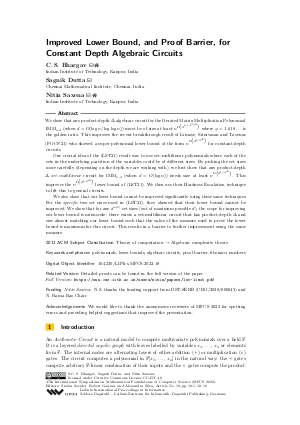LIPIcs.MFCS.2022.18.pdf
- Filesize: 0.7 MB
- 16 pages

 Creative Commons Attribution 4.0 International license
Creative Commons Attribution 4.0 International license

We show that any product-depth Δ algebraic circuit for the Iterated Matrix Multiplication Polynomial IMM_{n,d} (when d = O(log n/log log n)) must be of size at least n^Ω(d^{1/(φ²)^Δ}) where φ = 1.618… is the golden ratio. This improves the recent breakthrough result of Limaye, Srinivasan and Tavenas (FOCS'21) who showed a super polynomial lower bound of the form n^Ω(d^{1/4^Δ}) for constant-depth circuits.
One crucial idea of the (LST21) result was to use set-multilinear polynomials where each of the sets in the underlying partition of the variables could be of different sizes. By picking the set sizes more carefully (depending on the depth we are working with), we first show that any product-depth Δ set-multilinear circuit for IMM_{n,d} (when d = O(log n)) needs size at least n^Ω(d^{1/φ^Δ}). This improves the n^Ω(d^{1/2^Δ}) lower bound of (LST21). We then use their Hardness Escalation technique to lift this to general circuits.
We also show that our lower bound cannot be improved significantly using these same techniques. For the specific two set sizes used in (LST21), they showed that their lower bound cannot be improved. We show that for any d^o(1) set sizes (out of maximum possible d), the scope for improving our lower bound is minuscule: there exists a set-multilinear circuit that has product-depth Δ and size almost matching our lower bound such that the value of the measure used to prove the lower bound is maximum for this circuit. This results in a barrier to further improvement using the same measure.
Feedback for Dagstuhl Publishing